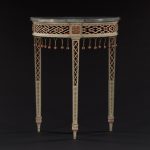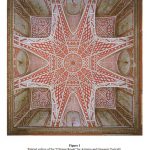9768 AN EXTRAORDINARY PAIR OF CHINOISERIE RED AND WHITE PAINTED DEMI-LUNE SIDE TABLES Italian. Last Quarter Of The Eighteenth Century. Measurements: Height: 29 3/4″ (75.5 cm) Width: 23 1/4″ (59 cm) Depth: 12″(30.5 cm)

-
Figure 1
Research
Of red and white painted beech and painted metal wire. The demi-lune gray veined marble top above a pierced Chinese paling pattern frieze interspersed with three carved square foliate paterae. From the frieze is suspended an arcade of painted metal wire loops terminating in a striped painted wood ball. Each of the three legs pierced with Chinese paling pattern design below which is a carved pendant of repeating diminishing circles and lozenges. Each leg raised on square tapering spaded foot. Paint refreshed in some areas.
Provenance:
Estate of Polly Stover Kahn, New York
The Italian preference for Eastern decoration, manifest in the present pair of side tables, began with the expansion of trade with China, leading to intensified taste for chinoiserie throughout Europe in the 16th and 17th centuries. Designers and architects to the court created interiors that drew heavily on exotic styles based on the ceramics, furniture, and paintings imported from the East; and by the 18th century these items were being produced at home.
The Piedmont region in Italy was particularly successful for constructing elaborate chinoiserie interiors, more than two-dozen of which are preserved in palaces and villas of Turin, its capital city. The “Chinese Room” of one palace in particular, Palazzo Grosso in Riva di Chieri, Turin, features an extraordinary painted ceiling by Antonio and Giovanni Toricelli (Figure 1) that mimics the intricate patterns of Chinese latticework garden fences. Very similar patterns to those on the Grosso ceiling are simulated in the paling of the frieze and legs of the present tables.
The tables are a most original interpretation of the Chinoiserie taste in Europe. The legs have the striking features of being fully fretted in their upper half allowing light to pass through. While the tables’ friezes have the apparently unique feature of arcaded wire loops suspended from them, which terminate in red and white spheres, in the manner of a silk passmonterie.
The previous owner of the tables, Polly Stover Kahn, was the wife of Gilbert Kahn and daughter-in-law of famed banker, industrialist, and philanthropist Otto Herman Kahn. Of German descent, Otto worked for Deutsche Bank in London until 1893 when he came to the United States and joined Kuhn, Loeb & Co., one of the most influential investment banks at the turn of the century. He became an exceedingly wealthy financier, providing commercial support to artists and composers, and formed part of the board of the Metropolitan Opera Co. 1919 signaled the completion of his 443-acre estate on the Gold Coast of Long Island. At the center sat Oheka Castle, a 127-room French-style château and the second largest private residence in America after the Biltmore, which served as part of the inspiration for F. Scott Fitzgerald’s novel, The Great Gatsby. After Otto Kahn’s death in 1934 the Oheka estate fell out of family ownership, however, Gilbert and Polly Kahn had a nearby estate on Long Island and it is likely that he and his siblings inherited the partial contents of Okeha’s lavish interiors.


Comments are closed.